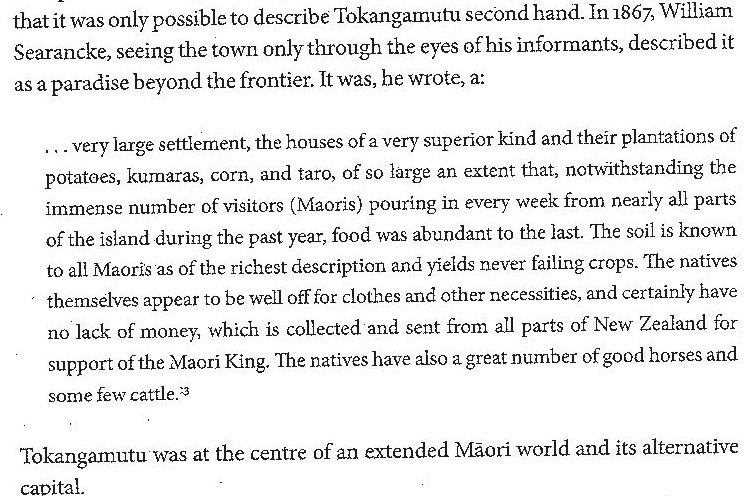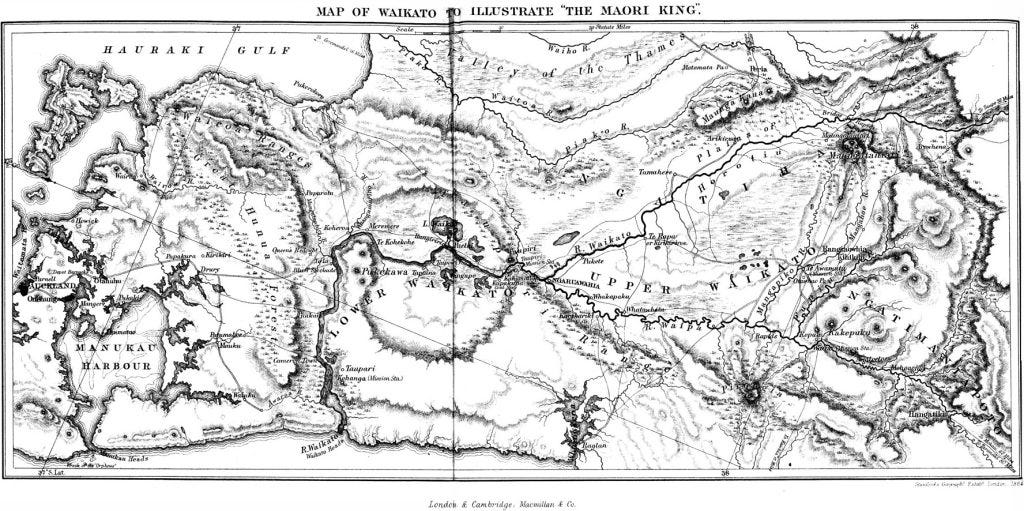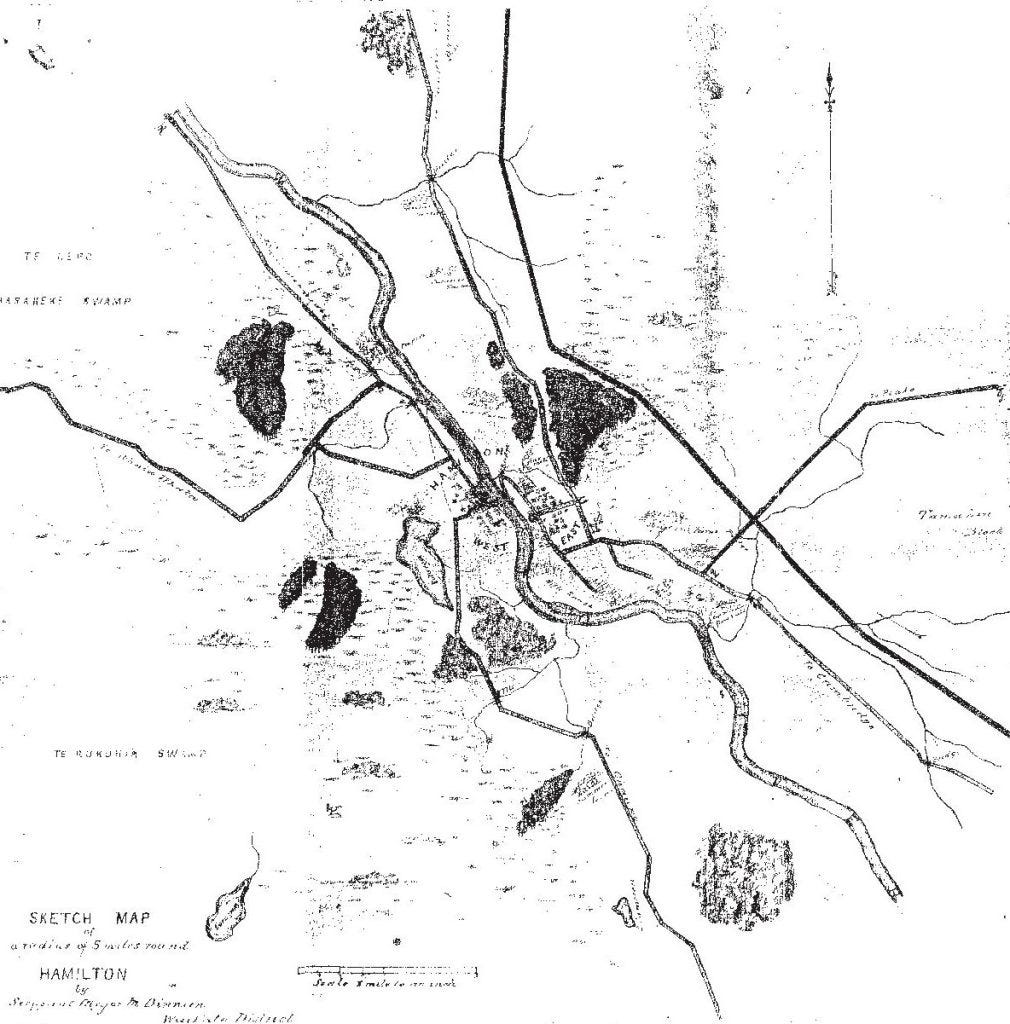Waikato in the 1860s: from abundance to a time of hunger
This post is part of a series of posts on my notes on the history of modern town planning, which have previously covered the periods from 1648-1806, 1800-1840s and 1840s-1850s.
For this post my notes are only on Waikato and I’m starting with the last line in John Eldon Gorst’s book The Maori King – ‘truth, if it is ever to be known at all, can only be obtained by inquiries made in the native villages of New Zealand’ (p409). I apologise for the fact that some of these notes are a bit random. The first refers to a ferry in the early 1860s: ‘The ferry at Pukete paid in one year 5l. to the King’ (p282) ... Pukete, is passed. Above this lies the district of Horotiu [Waikato] ... Horotiu [Waikato] is a perfectly level plain of light rich soil, with a gravelly subsoil, extending inland from both banks of the river. Detached clumps of trees dotted all over the plain give it a beautiful park-like appearance, while the land between is covered with cultivations and villages ... the wide, open country, in which English grass and clover spread like weeds, affords abundant pasture for their horses and cattle ... In summer, large crops of melons and pumpkins are raised, and eaten as fast as they ripen; and for fruit, there is abundance of peaches, which grow wild about the country ... The soil is so fertile, that, with ploughs and bullocks, very few days' labour will produce food enough for the year (p26) ... [and] natives were no longer generally willing to allow land to be sold (p48)

My notes from the book Dancing with the King – The rise and fall of the King Country 1864-1885 - by Michael Belgrave - ‘In British history, rebellion, even when imagined, had been a justification for the seizure of noble lands by the crown. (p13) ... Even as the legislation was being passed, military settlers were being recruited ... These settlers were promised grants of confiscated land when the legal processes for confiscating that did not exist and its location remained unknown ... In late 1866, land had not been allocated for the settlers and the three years of rations they had been assured of had come to an end. ... [Once the settlers had their allotment] Many simply walked off the land and sold out to Auckland speculators, who amassed vast estate... Betrayal and Hunger: ... Maori who had survived the war and had supported the Kingitanga were faced with dramatic economic and social deprivation which followed the loss of the fertile food basket that had been taken from them by confiscation ... The months immediately after the final battles [1864] were remembered by the Kingitanga as the time of hunger. The crops that had been about to be harvested in autumn were lost and looted. ... Starvation and disease were never far away. (p15-17) ... Following the trauma of the hungry years immediately after Orakau, the Kingitanga re-established itself at Tokangamutu (Te Kuiti) under Ngati Maniapoto patronage, where by 1867 a town had developed that was economically self-sufficient ... In 1867 ... informants, described it as a paradise beyond the frontier’ (p21).

Armed Settlers: The story of the founding of Hamilton, 1864-1874. By H C M Norris
Sorry again, this first note is a bit random. ‘Tamahere, in 1863, was a large village of some three to four hundred inhabitants’ (p3) ... [Armed Settlers] No man above the age of 40 years will be accepted and every applicant will be subject to an examination ... must produce such certificates of good character, health and general fitness ... Each settlement will comprise not less than 100 town allotments and 100 farm sections ... Every settler ... will be entitled to one town allotment and one farm section ... he will be entitled to receive rations, free of cost for twelve months ... No settler ... the first three years after his enrolment in the Militia to absent himself from his settlement ... On the expiration of three years. ... Any settler will be permitted to dispose of his land to any person approved of by the Government (p16-18) ... the Colonial Government, in ... November 1863, considered it necessary to confiscate five and a half million acres (P37) ... June 1864 ... the Government had chosen sites for settlements at Alexandra, Cambridge, Kihikihi and Hamilton (p39)... [for] villages from 300 to 500 men (p40) ... 24th August 1864 ... the ‘Pioneer’ drew up on the east bank of the river (p43) ... P57 the work of the Maoris still remained. “The cultivated lands of the Maoris are seen stretching inland and upward over a beautiful country, lovely and dry. Their paddocks, enclosed with fences, show where their stores of potatoes, Indian corn and wheat have been grown, and the potato pits, constructed in the style peculiar to the race, attest the abundant crops they have obtained”(p49) ... December 1864, a census was taken. ... In Hamilton ... males, 836; female, 660; total 1,496; (p56) ... Reserves for various purposes were set aside. In October 1867, there were about 700 acres as timber reserves; 10 acres in both Hamilton East and Hamilton West for stockades, as well as the redoubts, 5 acres for cattle and horse markets, areas for landings, (reserves for rifle ranges and a central race-course), public squares, recreation and park areas and cemetery: and quite a number of town sections for church endowment and ... sections, for hospital and school endowments (p69) ... July 1865 ... The population consisted of some 400 adult males ... total was some 1,500 souls (p113-114) ... The year 1866 ... In Hamilton ... four out of five potato crops had failed. A letter ... to the Weekly News in November said: “A comrade of mine called on me ... beg a candle, a bit of tea, sugar and bread. He said that neither himself nor his family had tasted food for twenty-four hours. I know of many similar cases ... who will not be able to get seed for their acres, and most of the crops failed last year.” The winter was a hard one ... Several horses and bullocks died in the swamps looking for feed. Cattle wandering in search of feed destroyed the crops of neighbours, and a public pound was opened (p146-147) ... The 1866-67 vegetable gardens were laid waste by a plague of Caterpillars (p151) ... meeting of electors of the Hamilton Highway District was held on Saturday, 26th September 1868 (p165-166) ... A committee was formed to establish a public library in Hamilton East (p186) ... Hamilton East had a population of 169 males and 131 females. The figure for Hamilton West were 200 and 166. Exclusive of Maori the Kirikiriroa [Hamilton East]Highway District had a population of 138, the Hamilton Highway District 131 and Tamahere Highway District 72 ... In Hamilton East there were fifty-three wood and iron dwellings and two sod huts ... The number of houses in Hamilton West was seventy-one (p212) ... In 1869 the population of the town was at its lowest (p218).
End





